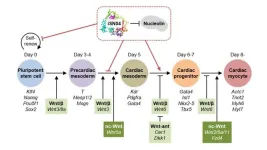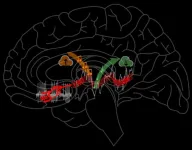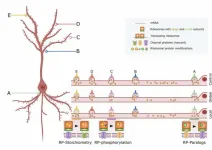(Press-News.org) University of Virginia researchers are working to outrace two dangerous germs known for quickly developing resistance to new antibiotics – and the scientists’ efforts could help us better combat antibiotic resistance more broadly.
A team led by Jason Papin, PhD, is developing sophisticated computer models of Staphylococcus aureus and Pseudomonas aeruginosa, two multi-drug resistant bacteria that infect thousands of Americans every year. The researchers will use their models to better understand the cellular processes and gene activity that make the bacteria so adept at overcoming antibiotics.
The researchers will then take their findings to the lab as part of an ambitious effort to identify vulnerabilities in the bugs and advance the development of new and more effective treatments.
By identifying shared traits in the bacteria, the researchers hope to discover common links – and weaknesses – among germs that are adept at developing antibiotic resistance, a growing problem in the United States and around the world.
“Antibiotic resistance is an enormous clinical problem that is only getting bigger. With so many complex processes involved in how bacteria evolve antibiotic resistance, we have to use systems approaches, combining computer modeling and sophisticated experiments, to try to tackle this important challenge,” said Papin, of UVA’s Department of Biomedical Engineering, a joint program of UVA’s School of Medicine and School of Engineering. “We hope that these computer models and experimental approaches will help us understand new vulnerabilities in antibiotic-resistant bacteria and consequently lead to new therapies to treat infection.”
ANTIBIOTIC RESISTANCE CRISIS
The federal Centers for Disease Control and Prevention has labeled antimicrobial resistance an “urgent global health threat.” It’s estimated that antibiotic-resistant germs killed at least 1.27 million people worldwide and contributed to nearly 5 million deaths in 2019. The United States alone sees more than 2.8 million antibiotic-resistant infections each year.
Papin and his team are targeting two important contributors to those alarming numbers. The Staphylococcus aureus bacterium is very common – it’s found in approximately 30% of people’s noses. It’s typically harmless, but for some people – especially the elderly and the immunocompromised – it can trigger serious, even deadly infections. For example, it can cause pneumonia and the full-body infection known as sepsis. That makes it a serious threat in hospitals and nursing homes. It’s estimated to cause 200,000 drug-resistant infections each year in the United States.
Pseudomonas aeruginosa, meanwhile, is found in soil and water. But P. aeruginosa is a particular problem in healthcare settings, as it can cause pneumonia and other serious infections. The bacterium is estimated to have caused more than 32,000 infections and 2,700 deaths among hospitalized patients in 2017, the CDC reports. It too is particularly dangerous to the elderly and immune compromised.
$1.2 MILLION FROM NIH
Recognizing the importance of Papin’s efforts to battle these bugs, the National Institutes of Health’s National Institute of General Medical Sciences has awarded him a grant of more than $1.2 million. And he hopes his work will benefit the battle against antibiotic resistance more broadly by creating a useful platform for future research into other pathogens.
“We have a wonderful team of students and collaborators on this project, and we’re optimistic that this funding will provide the impetus necessary to make important discoveries to help us deal with the rise of antibiotic resistance,” Papin said.
The NIH grant is R01GM147257.
To keep up with the latest medical research news from UVA, subscribe to the Making of Medicine blog.
END
NIH provides $1.2 million for ambitious effort to battle antibiotic resistance
2023-10-10
ELSE PRESS RELEASES FROM THIS DATE:
Researchers test large language model that preserves patient privacy
2023-10-10
OAK BROOK, Ill. – Locally run large language models (LLMs) may be a feasible option for extracting data from text-based radiology reports while preserving patient privacy, according to a new study from the National Institutes of Health Clinical Center (NIH CC) published in Radiology, a journal of the Radiological Society of North America (RSNA). LLMs are deep-learning models trained to understand and generate text in a human-like way.
Recently released LLM models such as ChatGPT and GPT-4 have garnered attention. However, they are not compatible with healthcare data due to privacy constraints.
“ChatGPT and GPT-4 are proprietary models that require the user ...
DNA aptamer finds novel application in regulating cell differentiation
2023-10-10
Generating specific cell lineages from induced pluripotent stem cells and embryonic stem cells is the holy grail of regenerative medicine. Guiding iPSCs toward a target cell line has garnered much attention, but the process remains challenging. Now, researchers from Japan have discovered that an anti-nucleolin DNA aptamer, iSN04, can determine a cell’s lineage during differentiation. By demonstrating the generation of cardiomyocytes from murine pluripotent stem cells, their concept shows promise as a regenerative therapy.
Self-renewal ...
Monitoring African copper and cobalt mining emissions from space
2023-10-10
Emissions associated with mining operations in Africa’s Copperbelt can be quantified from space, according to new research led by the National Center for Atmospheric Research (NCAR).
Mining for copper and cobalt in Africa has rapidly increased, the latter in response to growing global demand for electric vehicles, laptops, smartphones, and other devices that rely on lithium-ion batteries, the vast majority of which contain cobalt.
The new study is published in Geophysical Research Letters, ...
Study compares health information exchange data versus patient self-reports to measure cancer screening uptake
2023-10-10
INDIANAPOLIS – Knowing which populations are following cancer screening guidelines is important to public health officials and policy makers as well as researchers developing strategies to improve adherence. A recent study is one of the first to compare using health information exchange (HIE) data with patient self-reported data as a means of gathering this intelligence.
The researchers found that completeness of information differed by data source and screening test. HIE data provided more information than patient self-reports about ...
Seamlessly multiplexing memory storage and recall
2023-10-10
Every day we store memories, some of which we are able to recall later. But while we do so, do we keep on storing? Yes! We cannot afford to stop memory formation while we are retrieving prior ones. Imagine, for instance, that you are navigating the city while recalling last night’s events to a friend tagging along. Your brain must memorize aspects of the route even while you are in the story, so that you can find your way back later or reach your next destination.
We seem to perform this task without much conscious effort. Big deal, one could say, as we know that the brain has trillions of synaptic connections, so parallel processing ...
UNIST recognized for design excellence at IDEA 2023!
2023-10-10
The design concept of a disaster alert balloon, capable of changing its color like a chameleon, has been honored for its design excellence at the internationally renowned International Design Excellence Award (IDEA) 2023.
The awarded concept, named SAFEUP, serves as a hazard indicator, providing visual information about the condition of accident sites from a safe distance. Developed by Professor Chajoong Kim and his team in the Department of Design at UNIST, SAFEUP has received the ‘IDEA 2023’ Bronze Award in the category of Concepts & Speculative Design. The ...
The ribosome–depression link
2023-10-10
A group of ribosomal protein genes connect animal models of depression to human patients with major depressive disorder. In order to research depression treatments, scientists use a mouse model, inducing a state with similarities to depression though exposure to variable, unpredictable, and uncontrolled stressors over days or weeks. But is this state molecularly akin to what humans with major depressive disorder experience? To find out, Xiaolu Zhang, Mahmoud Ali Eladawi, and colleagues examine transcriptomics data from postmortem human brain tissue and from several mouse models of stress, seeking to pinpoint conserved ...
Ionic crystal generates molecular ions upon positron irradiation, finds new study
2023-10-10
Positron, the antiparticle of electron, has the same mass and charge as that of an electron but with the sign flipped for the charge. It is an attractive particle for scientists because the use of positrons has led to important insights and developments in the fields of elementary particle physics, atomic physics, materials science, astrophysics, and medicine. For instance, positrons are known to be components of antimatter. They are also powerful in detecting lattice defects in solids and semiconductors and in structural analysis of the topmost surface of crystals. Positronic compounds, namely ...
Maternal obesity predicts heart disease risk better than pregnancy complications
2023-10-10
First study to determine the role pre-pregnancy obesity plays in future poor heart health
Those with overweight or obese BMI in early pregnancy had a higher risk of developing hypertensive disorders of pregnancy
‘If pre-pregnancy obesity is the culprit or cause of risk, we should be targeting this with interventions’
Pregnancy complications such as preeclampsia and gestational diabetes have recently been associated with a higher risk of developing heart disease later in life. But a new Northwestern Medicine study has found obesity before or during ...
Pregnancy complications increase and unmask short- and long-term cardiovascular risk for people with obesity
2023-10-10
Having obesity before and during early pregnancy appears to be a strong indicator of risk for developing future cardiovascular disease and was significantly linked with adverse outcomes during pregnancy such as high blood pressure, preeclampsia, and gestational diabetes, according to a study published in Circulation Research that was funded by the National Institutes of Health. Researchers have known obesity is a risk factor for cardiovascular disease and pregnancy complications related to blood pressure. However, they did not know which factors – obesity or the pregnancy complications – played larger roles in influencing a person’s ...





